Best Epiphone Les Pauls 2025: Our pick of the greatest budget-friendly versions of Gibson’s iconic single-cut
Whether you’re a beginner or a seasoned guitarist, our list of the best Epiphone Les Pauls is sure to inspire you
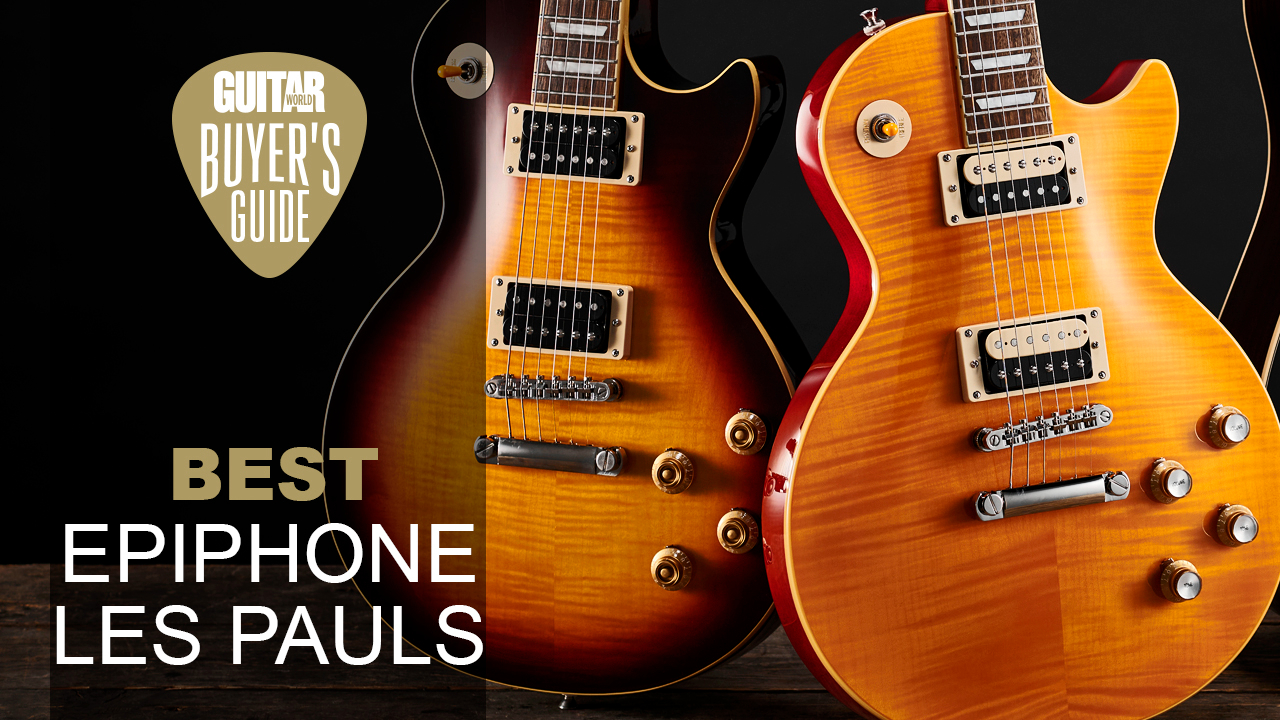
If you’re just starting out on your guitar-playing journey, you’re probably wondering what we mean by the best Epiphone Les Pauls. How exactly do they differ from standard Les Pauls? OK, let us explain...
For many guitarists, the Gibson Les Paul is the alpha and omega of electric guitar design. Gibson’s peerless single-cut was the original aspirational guitar. It has the tone. It has the aesthetic. The thing is, even with Gibson’s Tribute Series offering a stripped-down Les Paul at a knockdown price, not all of us can afford a US-built model. That’s where Epiphone – a Gibson brand since 1957 – comes in.
Some Epiphone Les Pauls are the perfect beginner electric, priced to be someone’s first guitar. Others offer an approachable second guitar, for intermediate players who are getting serious about the instrument and want to take their playing and their sound to the next level. And it’s indicative of the energy and innovation afoot in Epiphone HQ that the manufacturer also offers models that serious players will consider on their own merits.
We’ve hand-selected the best Epiphone Les Pauls on our list, with something for everyone. We’ll link to the best deals, too. So let’s take the car off Craigslist before you do anything silly, and see if we can find you a great LP that you don’t need to sell the family silver for.
Our top picks
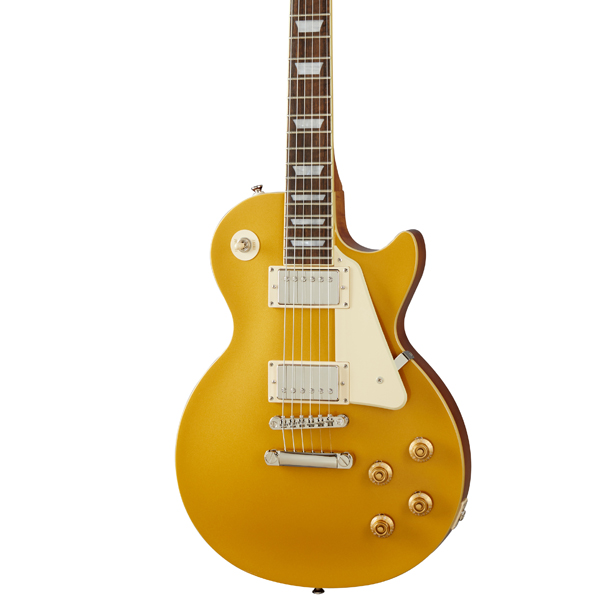
With its ProBucker pickups (which replicate the vintage Alnico II magic of the original PAF humbuckers), classic finish and tonewood cocktail of solid mahogany and maple up top, the Epiphone Les Paul Standard ’50s in Metallic Gold is a real chip off the old-school block. The neck profile is reassuringly meaty and supremely comfortable; and should you feel like bending a note and holding it, you’ll be knocked out by the sustain.
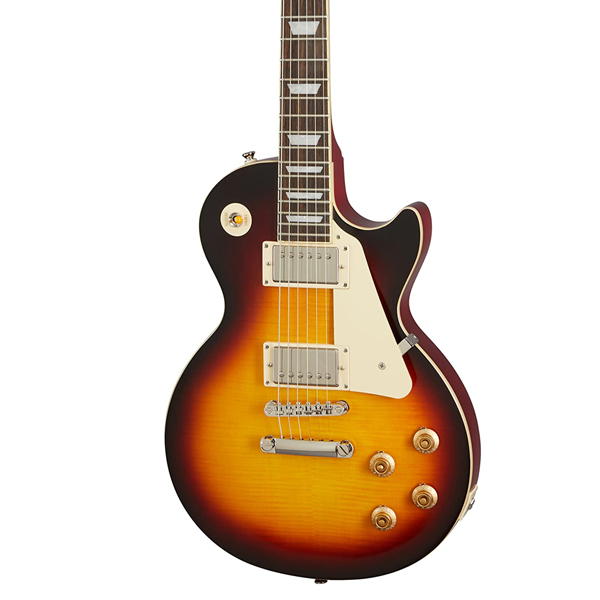
The first thing you might notice is the AAA flame maple on the top of the guitar. It’s not quite a thick cap like on the original models, but it’s a very handsome feature at this price, and really pops. While it’s not relic’d in any way, the aged gloss finish gives the 1959 Les Paul Standard Outfit a lived-in VOS vibe.
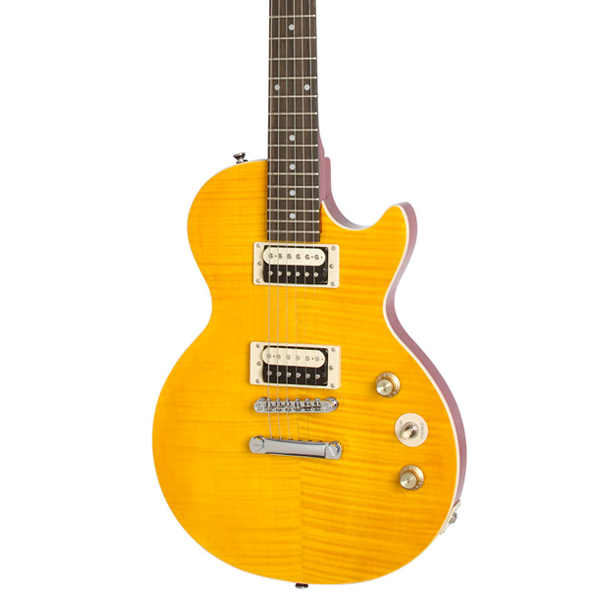
The Epiphone Les Paul Special II makes for an excellent beginner’s guitar. We could make the case for its inclusion on the basis of its respectable build, its classy figured maple veneer and dark-cherry-stained body giving it the look of Slash’s legendary Appetite For Destruction guitar – which, let’s be real, wasn’t a Gibson either but a Kris Derrig replica.
Best overall
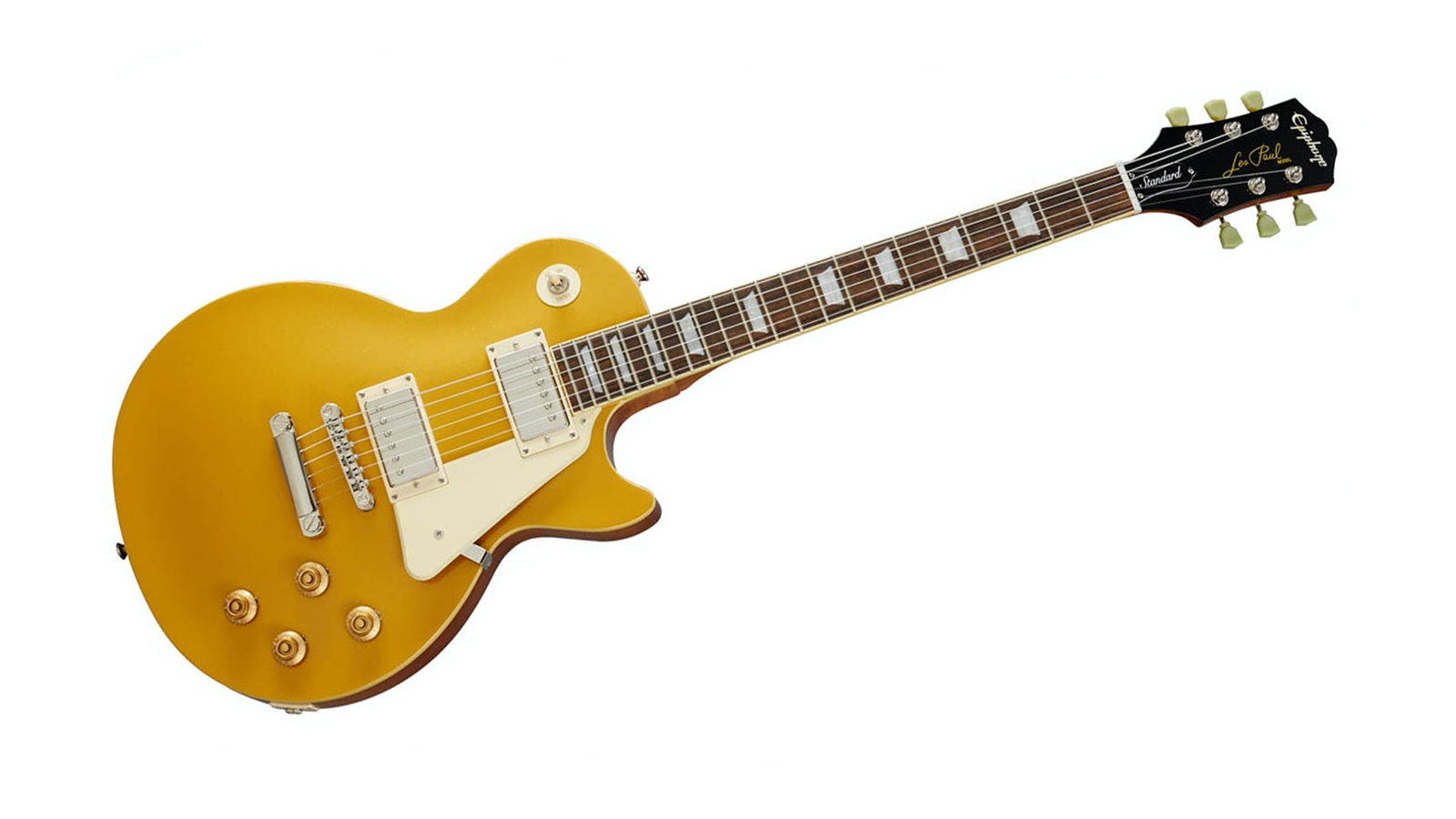
Specifications
Reasons to buy
Reasons to avoid
The Epiphone Les Paul Standard ’50s is a home run for Epiphone. Built for traditionalists, it features a big ol’ neck that fills the palm, making it extremely comfortable to wield. Described by Epiphone as a “rounded medium C-profile”, the neck is glued to the body via a long neck tenon – a deeper-set neck joint that adds mass and can enhance sustain if all other things are equal.
Well, there’s no shortage of sustain here, and in a blind test the Epiphone Les Paul Standard ’50s more than held its own. It feels like a Les Paul – a heavy one at that – and it looks the part, too. Sure, there’s Indian laurel on the 12”/30.5cm fingerboard, but it’s a decent rosewood substitute and the trapezoid inlays are tastefully applied. The finish options are excellent, though if pushed we’d opt for the Metallic Gold.
Furthermore, this sounds like a Les Paul. The ProBuckers are outstanding pickups. With an Alnico II magnet, these PAF-alikes are finely balanced – warm, with some width to the tone and no muddiness. There’s an exceptional level of clarity in the high end, and you lose none of it as you roll the volume back. The ’50s-style wiring loom features high-quality CTS pots, meaning both tone and volume controls do their job and taper off nicely.
That’s one of the great things about the Les Paul’s design. With its exquisite tonewood cocktail – the low-end authority and warmth of mahogany paired with the brightness of maple – the dual-volume/dual-tone setup operates as a powerful onboard EQ, allowing you to mine the guitar for all kinds of sounds.
You could dial in some jazz tones. Rock? Absolutely. The ProBuckers offer moderate output, but through an overdriven amplifier they’ll really sing. Add some fuzz or distortion and this guitar will do metal, too. Alternatively, the Epiphone Les Paul Standard ’50s has a voice that makes it a natural for blues. There’s artery-clogging cream at the neck, while the slightly overwound bridge pickup can put some stinging heat into your boogie-woogie shuffle – just like you can with a US-built Les Paul.
Read the full Epiphone Les Paul Standard ’50s review
Best playability
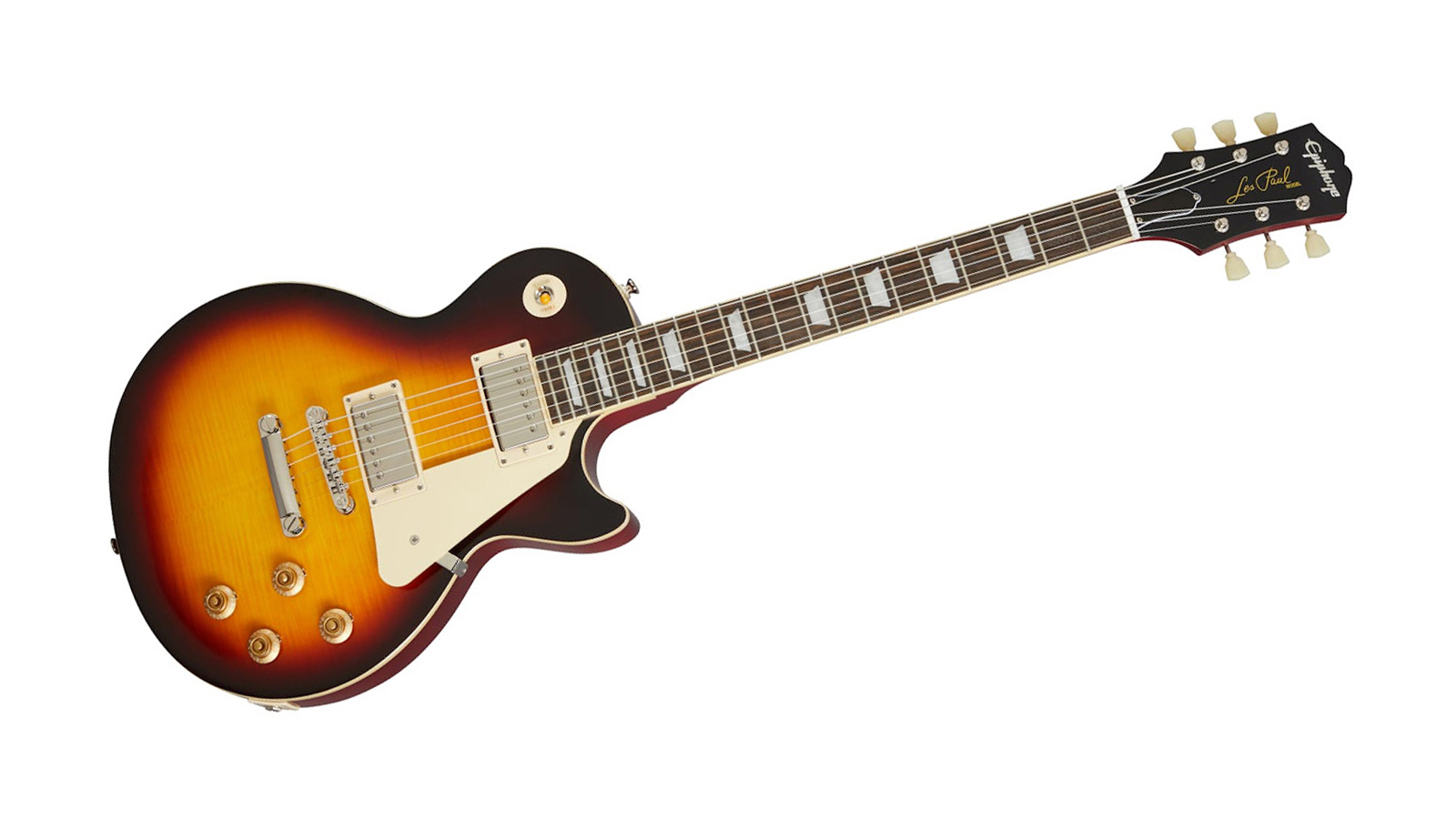
Specifications
Reasons to buy
Reasons to avoid
The result of a collaboration between Epiphone and the Gibson Custom Shop, the 1959 Les Paul Standard Outfit is inspired by the Holy Grail of vintage guitars, the 1959 Les Paul Standard. And, it has to be said, it’s a very special instrument.
The first thing you might notice is the AAA flame maple on the top of the guitar. It’s not quite a thick cap like on the original models, but it’s a very handsome feature at this price, and really pops. While it’s not relic’d in any way, the aged gloss finish gives the 1959 Les Paul Standard Outfit a lived-in VOS vibe.
Some of the best Epiphone Les Pauls make great options for modding, but the manufacturer has done the modding here. How do you improve upon this? There are a pair of Gibson USA BurstBuckers at the neck and bridge positions, with top-quality components used throughout. The control circuit for the pickups comprises Mallory 150 polyester film caps and CTS pots. The toggle switch and output jack are made by Switchcraft and are built to last.
It might be one of the most expensive Les Pauls in the Epiphone lineup, but, as the old saying goes, you get what you pay for. As we’ve come to expect from Epiphone, the fit and finish are tip-top, and you can keep it that way because the guitar comes with a hardshell case – always a sign that the maker is proud of its work.
Read our full Epiphone 1959 Les Paul review
Best for beginners
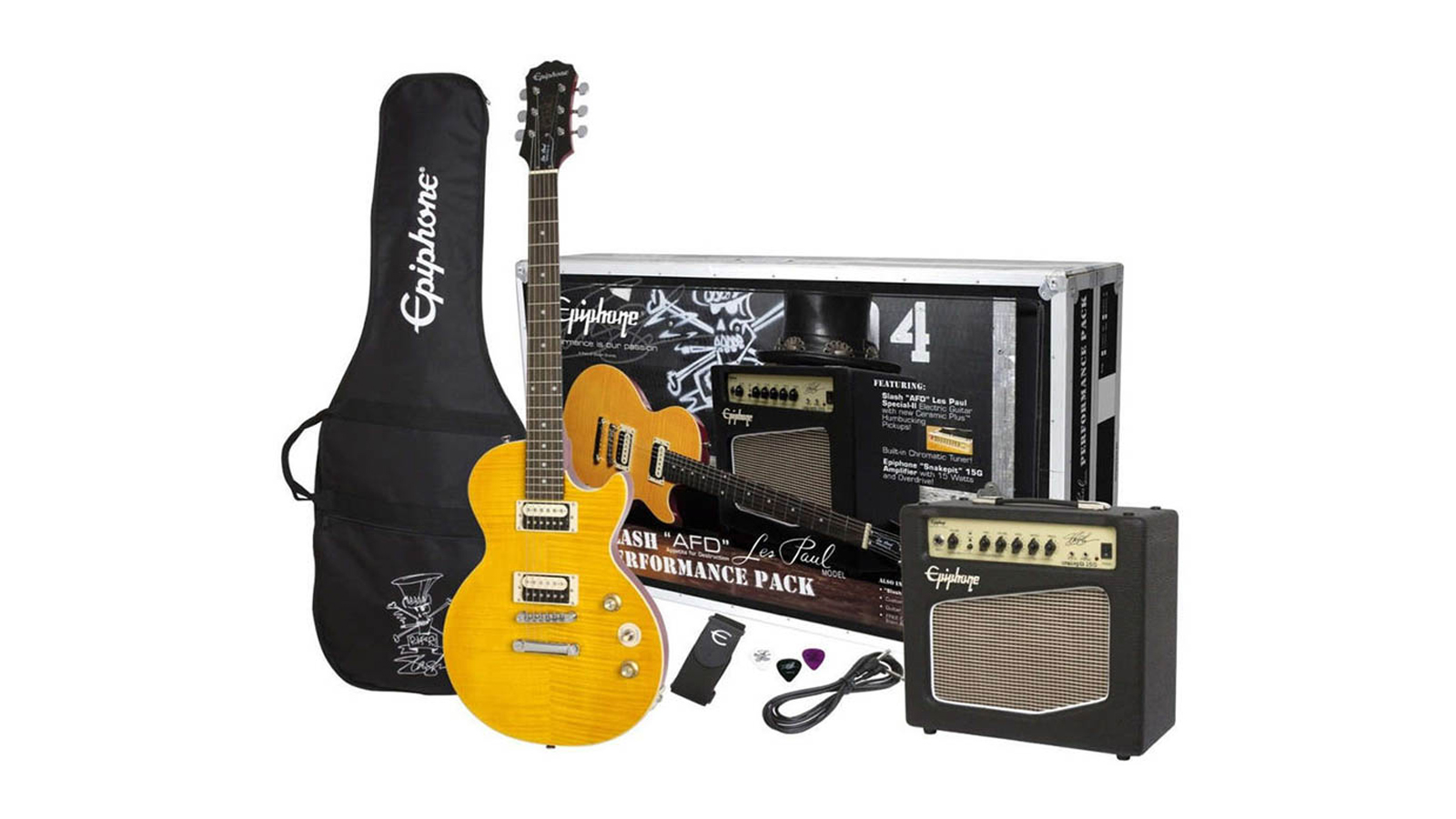
3. Epiphone Slash AFD Les Paul Special II Performance Pack
Our expert review:
Specifications
Reasons to buy
Reasons to avoid
The Epiphone Les Paul Special II makes for an excellent beginner’s guitar. We could make the case for its inclusion on the basis of its respectable build, its classy figured maple veneer and dark-cherry-stained body giving it the look of Slash’s legendary Appetite For Destruction guitar – which, let’s be real, wasn’t a Gibson either but a Kris Derrig replica.
This guitar also has a neat dual-humbucker setup. Those humbuckers have powerful ceramic magnets that make for aggressive, rocking tones – perfect for putting some power behind your first riffs.
But it’s the extras that make this such a great guitar for first-timers. As well as the instrument itself, you get a 15W Slash Snakepit-15 solid-state combo, a lead, a strap, a gig bag, plus some Slash signature picks. If you get lost after Smoke On The Water’s rhythm figure one, then you have some free eMedia online lessons to help demystify your first adventures with the guitar.
The amp has two channels, plenty of crunch on tap, a three-band EQ for comprehensive tone-shaping, and the all-important auxiliary input for playing along to your favorite tracks. There’s also a headphones output, which your neighbors will be very pleased about.
Best for punk
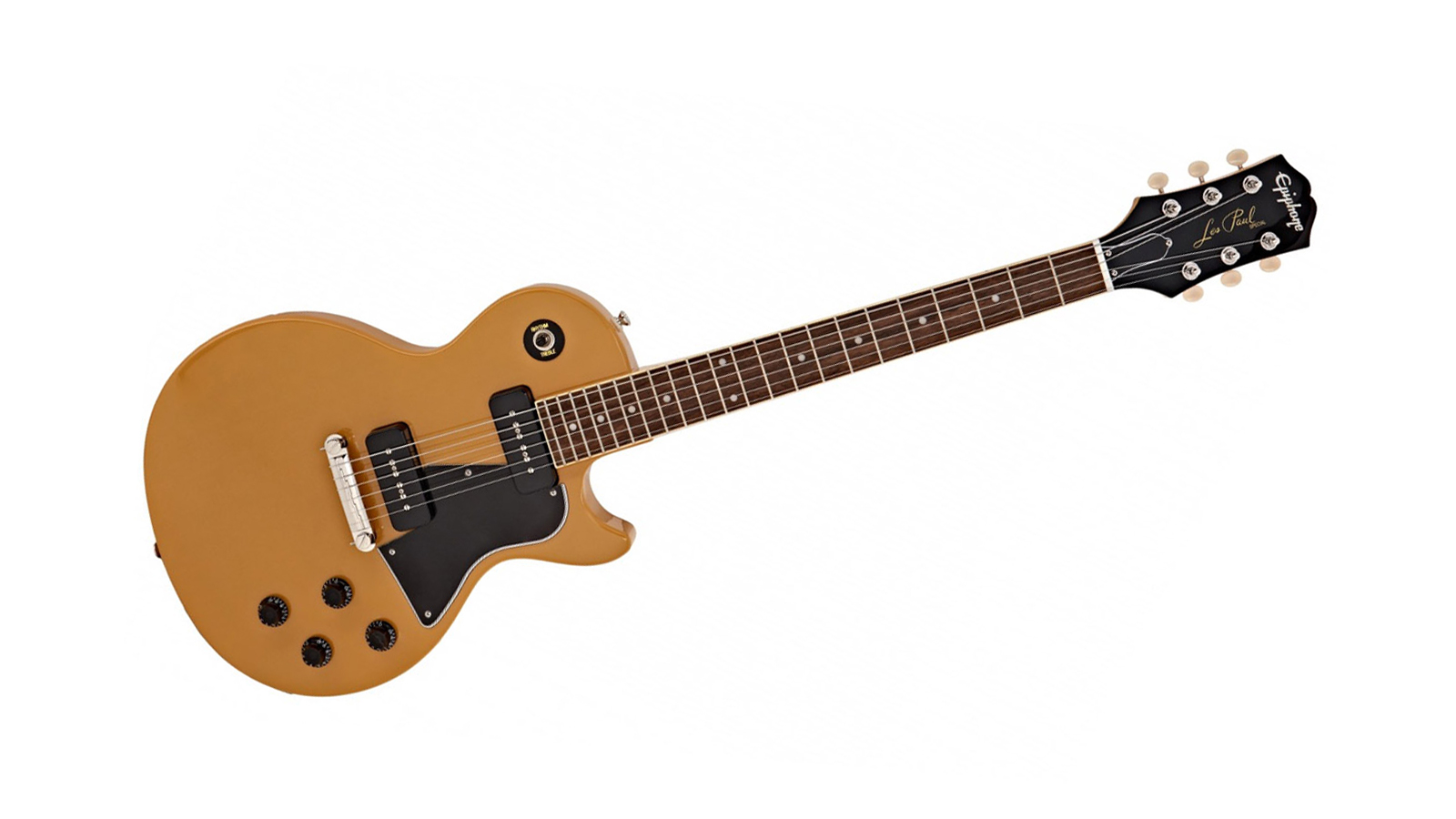
Specifications
Reasons to buy
Reasons to avoid
Like the other guitars on this list, the Epiphone Les Paul Special is constructed in the spirit of its Gibson forebears – except here, recreating the simple pleasures of a slab of mahogany with some strings requires fewer compromises. There’s no noticeable chamfering, belly cuts or any of those fancy things. It’s just a slab of wood with two hot P-90s.
Is the P-90 the best pickup of all time? The answer is, of course, yes, but then we all go ahead and get on with our lives, ignoring that fact and obsessing about vintage-correct PAF winds instead. Well, such is the pathology of the guitar nerd. Let it be said, however, that these soapbar pickups wail, articulating just what it is that makes the P-90 design so great. Roll the volume back and they are clean and precise, but with a little more warmth and less spike than regular single-coils. Dig in and they start to assert themselves. They’re not metal pickups but they certainly enjoy some drive, and really get going if you are so bold as to place a fuzz pedal between your guitar and amp.
OK, some players might prefer the Junior version with its solitary pickup. But for us, more is definitely more, and having two onboard makes for a very versatile Les Paul. Indeed, the Special is the darling of many a punk-rock, blues-rock, blues, jazz and indie-rock player.
Read our full Epiphone Les Paul Special TV Yellow review
Best for metal
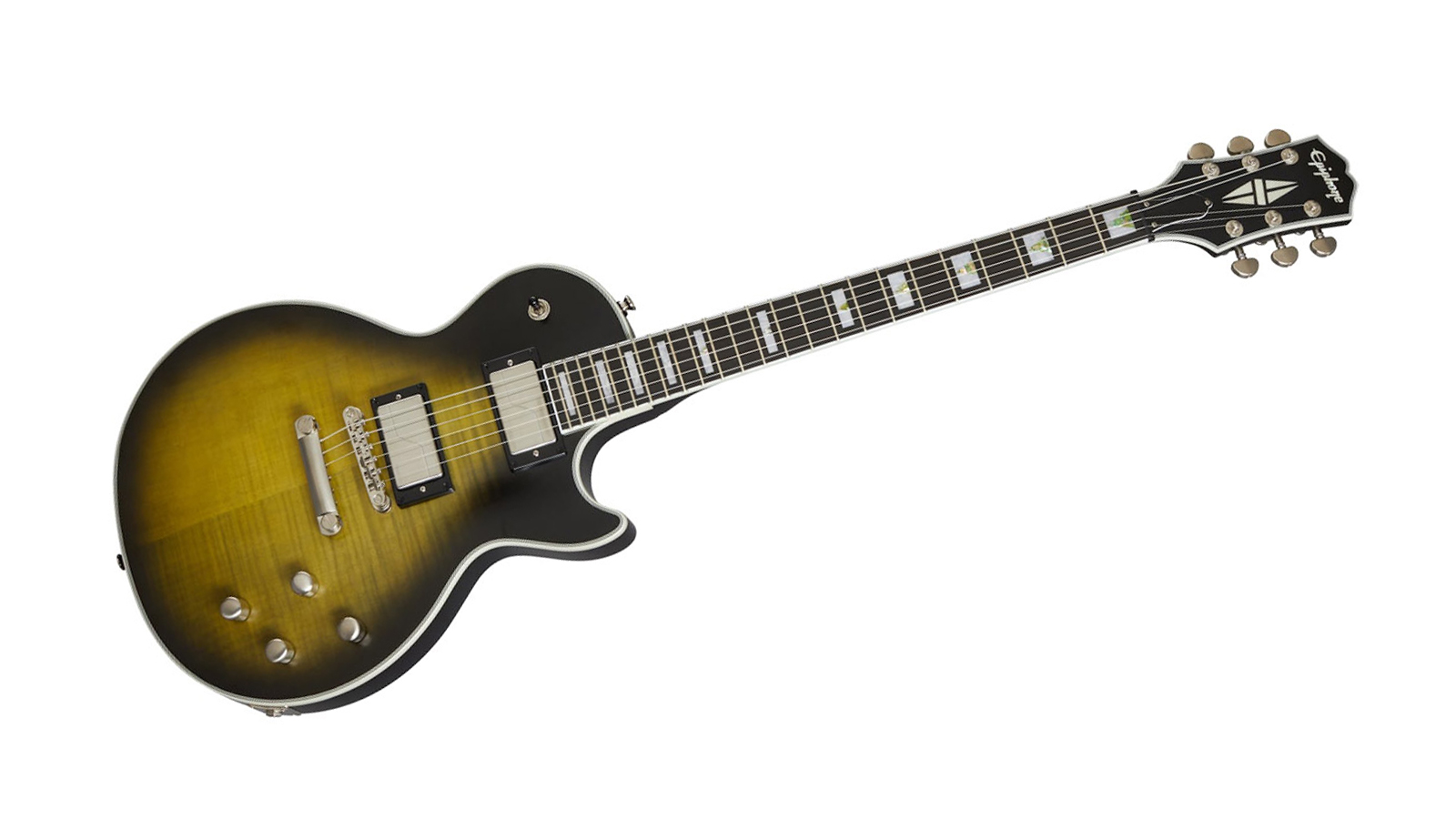
5. Epiphone Les Paul Prophecy
Our expert review:
Specifications
Reasons to buy
Reasons to avoid
You can play metal on pretty much any guitar, if your will is strong. You can certainly play metal on any of the aforementioned Les Pauls. But some guitars make it easy; guitars such as the Epiphone Les Paul Prophecy. Spec’d especially for the dark arts, it’s a wholly uncompromising instrument. We’ve seen high-end Epiphones and vintage-inspired Epiphones, but this is all of the above and more. This is a high-performance Epiphone, and it’s thrilling.
It’s also very 21st century. Take the pickups. Here we have a set of active Fishman Fluence humbuckers, more commonly found on pro models from the likes of ESP and Ibanez. Bringing that multi-voiced performance to a Les Paul format, they’re powered by a 9V battery that’s secreted on the rear of the guitar, and they let you switch between contemporary high-gain voicing, where the output is hotter and the frequency response tighter; a PAF-style response with more-open dynamics, giving you a tone like the BurstBuckers found on the 1959 model; and a hum-free single-coil voicing.
There’s a subjectivity when it comes to neck profiles, but for our money that asymmetric neck profile is a real winner, finding the right balance between comfort and speed. Those who might be tempted by the superlative Flying - Prophecy over concerns that the Les Paul’s body mass made it too heavy can think again; the weight relief used on the body makes it a very different beast to heavy models such as the 1959 and the ’50s Standard.
Best modern
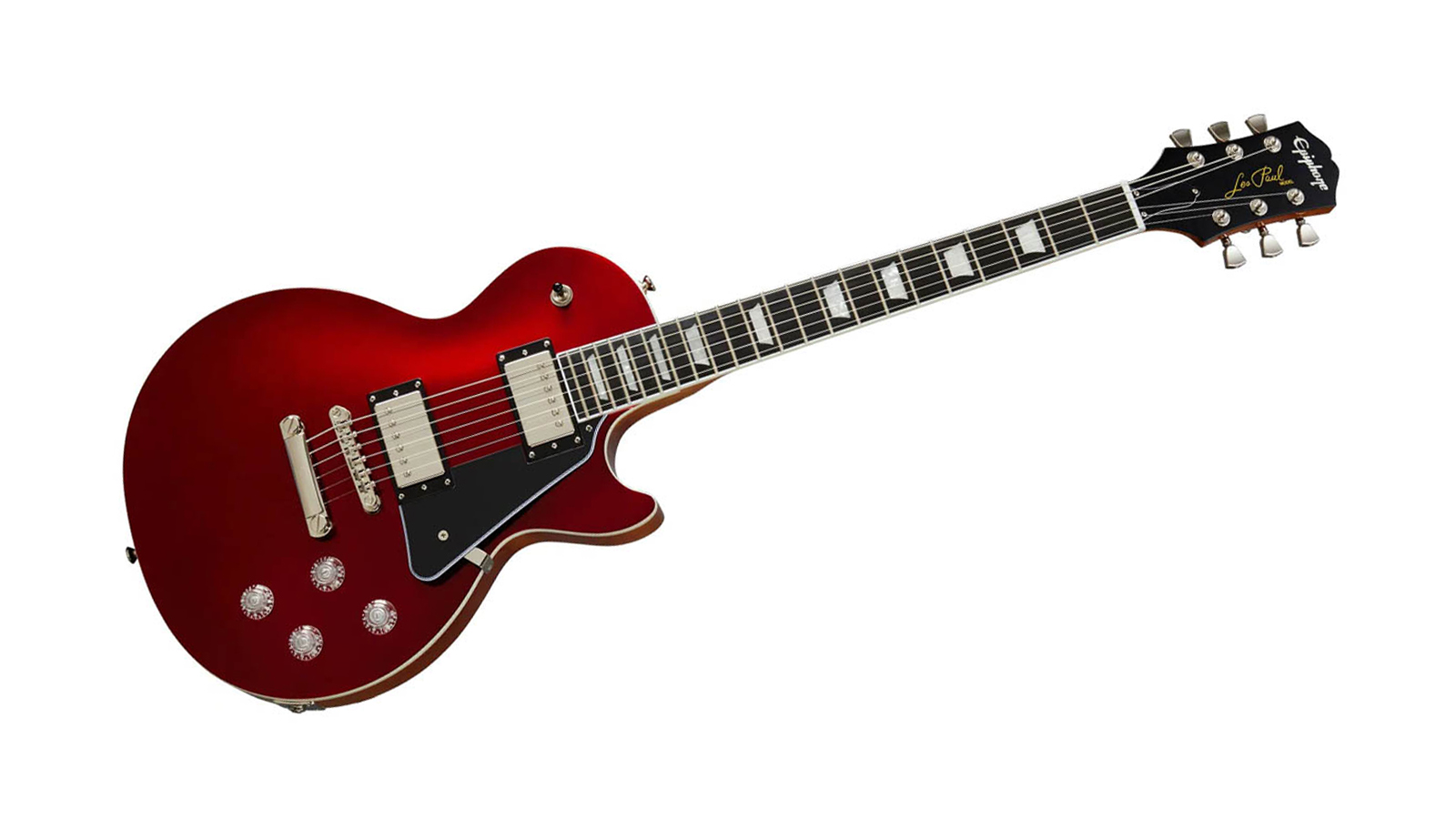
6. Epiphone Les Paul Modern
Our expert review:
Specifications
Reasons to buy
Reasons to avoid
The Les Paul is a heritage design, and so a certain amount of delicacy and diplomacy is required when it comes to updating the format. Modernizing the Les Paul is arguably the toughest job anyone at Gibson will have – ditto for Epiphone.
The Epiphone Les Paul Modern, built in the image of the Gibson US model, gets the balance right. Indeed, the finish options are quite conservative; Graphite Black, Faded Pelham Blue and Sparkling Burgundy all recall the solid colours of the late ’60s when Gibson was mindful of its great rival Fender’s ever-growing color palette and revised its finish options accordingly.
Like the Prophecy models, the Modern has an asymmetrical neck. It feels very much like a hybrid between a D and a C-profile, the flatter C-profile on the treble side helping players to negotiate busy lead guitar passages. Upper-fret access has been enhanced with a contoured heel joint.
While we have ProBucker pickups once more, the control circuit is a little more involved, incorporating a phase-switching function and a coil-tap. To play some classic rock, choose the full, natural humbucker voicing. For a soupçon of Peter Green, engage the phase-switching. Need some chime? Activate single-coil mode. There’s also a treble bleed circuit installed so that you don’t lose any high end as you roll the volume back.
Now, if you’re thinking that this update is a little too staid, and are asking where the retina-bothering finishes are, look no further than the Epiphone Les Paul Modern Figured, named for its AAA flame maple veneer. There, you’ve got a choice of some outré color-burst finishes. Caffe Latte Fade? We’ll take one to go – hey, it’s nice to have the option.
Best signature
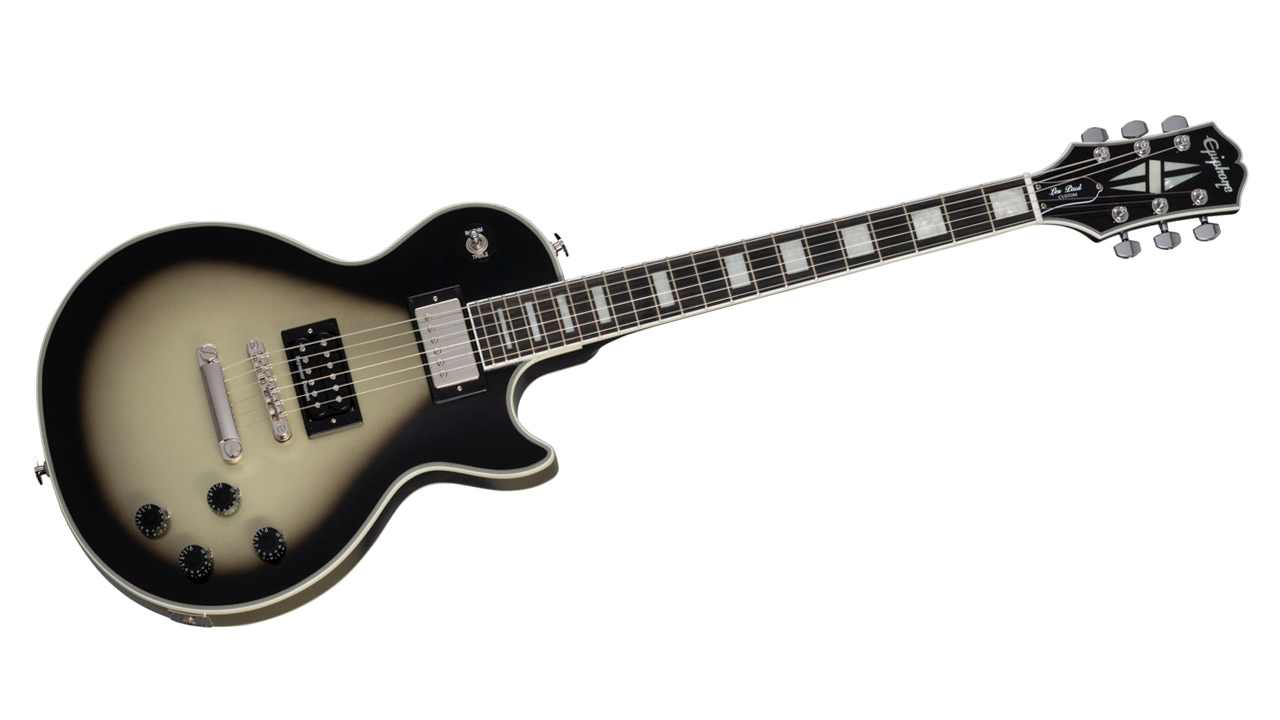
Specifications
Reasons to buy
Reasons to avoid
If the Gibson Les Paul epitomizes the aspirational guitar, then the Gibson Les Paul Custom takes this concept and runs with it, putting a split-diamond inlay on the headstock, block inlays on the fretboard and multi-ply binding all over the place.
Now, one big fan of the glorious LP Custom is Adam Jones of Tool, who is often seen with his beloved '79 Silver Burst around his neck. Of course with the Gibson Adam Jones signature proving to be a smash hit, it was only a matter of time until the classy Custom got the Epiphone treatment.
The Epiphone Adam Jones features a stunning work of art on the back as well as the usual LP Custom appointments such as a bound mahogany body with a maple cap, a three-piece bound maple neck - with an Adam Jones Custom profile - and an ebony fretboard.
At the heart of this guitar is the Seymour Duncan Distortion humbucker, which delivers all the power you'd ever need, while the Epiphone ProBucker Custom in the neck is reverse-mounted to mimic Adam's original guitar.
Read our full Epiphone Adam Jones Silverburst Les Paul Custom review
Buying advice
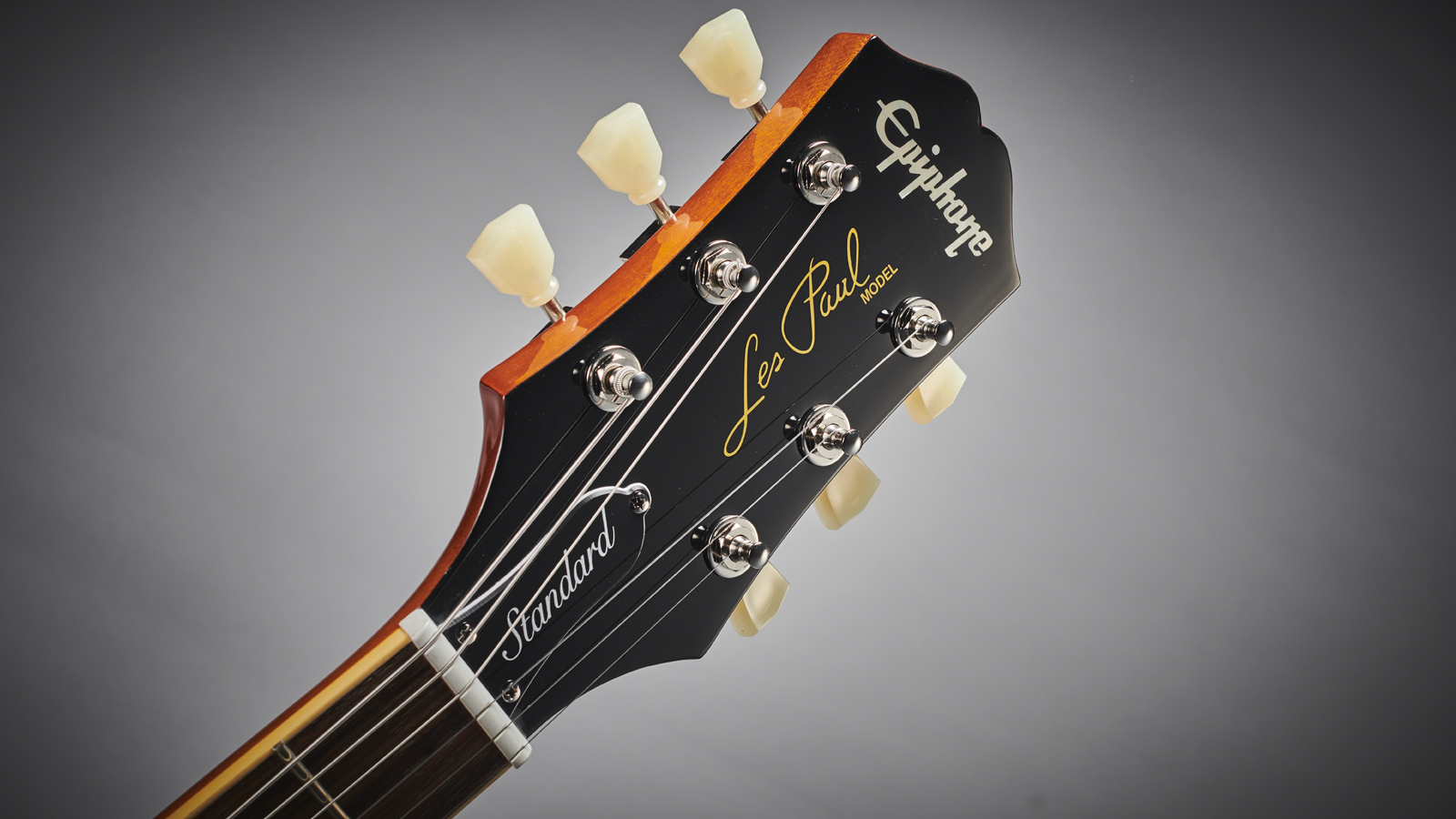
The 2021 Epiphone lineup is split into two categories: Original and Inspired By Gibson. As the name implies, the Original category is populated by Epiphone designs that you won’t find anywhere else – i.e. on the Gibson website. You’ll find guitars such as the Casino, the Wiltshire and the Coronet in there, and it really is quite thrilling to see some of these back in production with fresh finishes and updated spec.
The Inspired By Gibson models are, by some distance, a larger collection, and this is where the ES models, the SG, the Flying V, the Explorer, the Firebird and – of course – the Les Paul are listed. These designs have been with us since the 1950s and early ’60s. Modernizing a collection such as this is not easy when there’s a brand heritage to be maintained, but looking at Epiphone’s lineup versus Gibson, there’s clearly a little more room for maneuver.
We see that in the Prophecy series, which aggressively appropriates Gibson’s Flying V, Les Paul and Explorer, and weaponizes them with active, multi-voiced Fishman Fluence humbuckers. They are perfect for metal, and even have a little visual flair with the abalone/MOP block fingerboard inlay and split-diamond on the headstock.
The most forward-thinking design in both the Gibson and Epiphone collections is the newly configured Les Paul Modern. From the front, it looks like a regular Les Paul Standard with some jazzy crystal-clear control knobs and a finish that recalls Gibson’s late-’60s adventures in solid metallic colors. Yet turn it around and you’ll find a contoured heel to enhance upper-fret access. Also, under the surface, the guitar’s body has a number of cavities in it to reduce weight, along with a control circuit with push-pull functions to activate a P-90 mode when required. It’s pretty nifty, not straying too far from the original vision while offering some mod cons that today’s player might appreciate.
You might expect the two brands to be rigidly aligned when it comes to finish options, but here, Epiphone has a little more scope to experiment, offering the Les Paul Modern Figured in some unorthodox bursts that might just catch the eye of anyone tiring of the same old.
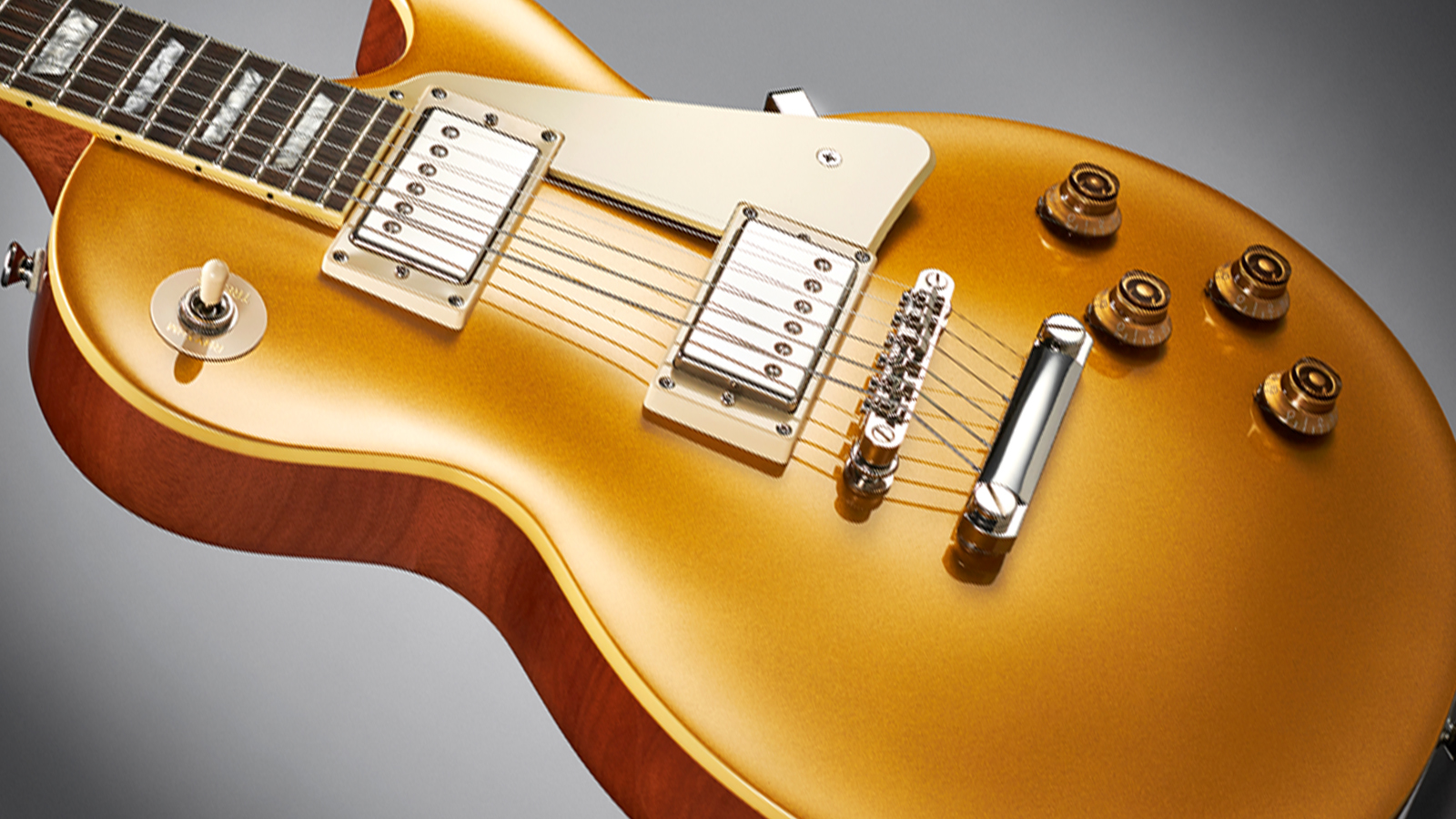
Are Epiphone guitars for beginners?
Epiphone might be more affordable across the board than its parent company, but we shouldn’t typecast it as an entry-level brand. Just look at the 1959 Les Paul Standard Outfit – spec’d in the first collaboration between Epiphone and the Gibson Custom Shop, it’s a serious guitar at a reasonable but by no means cheap price.
The strategy seems clear: keep innovating at the top end of the range, adding better pickups and components, while scaling-down the spec for beginner models. After all, beginners can’t be spending 500 dollars on a guitar. The biggest differences you’ll find between the top-line Epiphone models and its most basic builds are that the entry-level models typically use bolt-on necks as opposed to the glued-in necks found on the rest of the range. The pickups and components are not quite of the same standard. No one would expect them to be.
As for the fundamental differences in build between a US-built Gibson and a Chinese-built top-of-the-line Epiphone? Besides the headstock, Epiphone fingerboards are made of Indian laurel while the US Gibsons are fashioned out of rosewood. On the Epiphone Les Pauls, you’ll find a maple veneer, while on Gibson models it’s a thicker cap that naturally imparts more influence on the tone of the instrument.
Though their histories and fortunes are inextricably linked, there will always be a little distance between the two brands. However, that gap is closing, and right now we would happily gig a high-end Epiphone Les Paul. The components, build, tone, feel and sustain make a compelling case.
How we choose
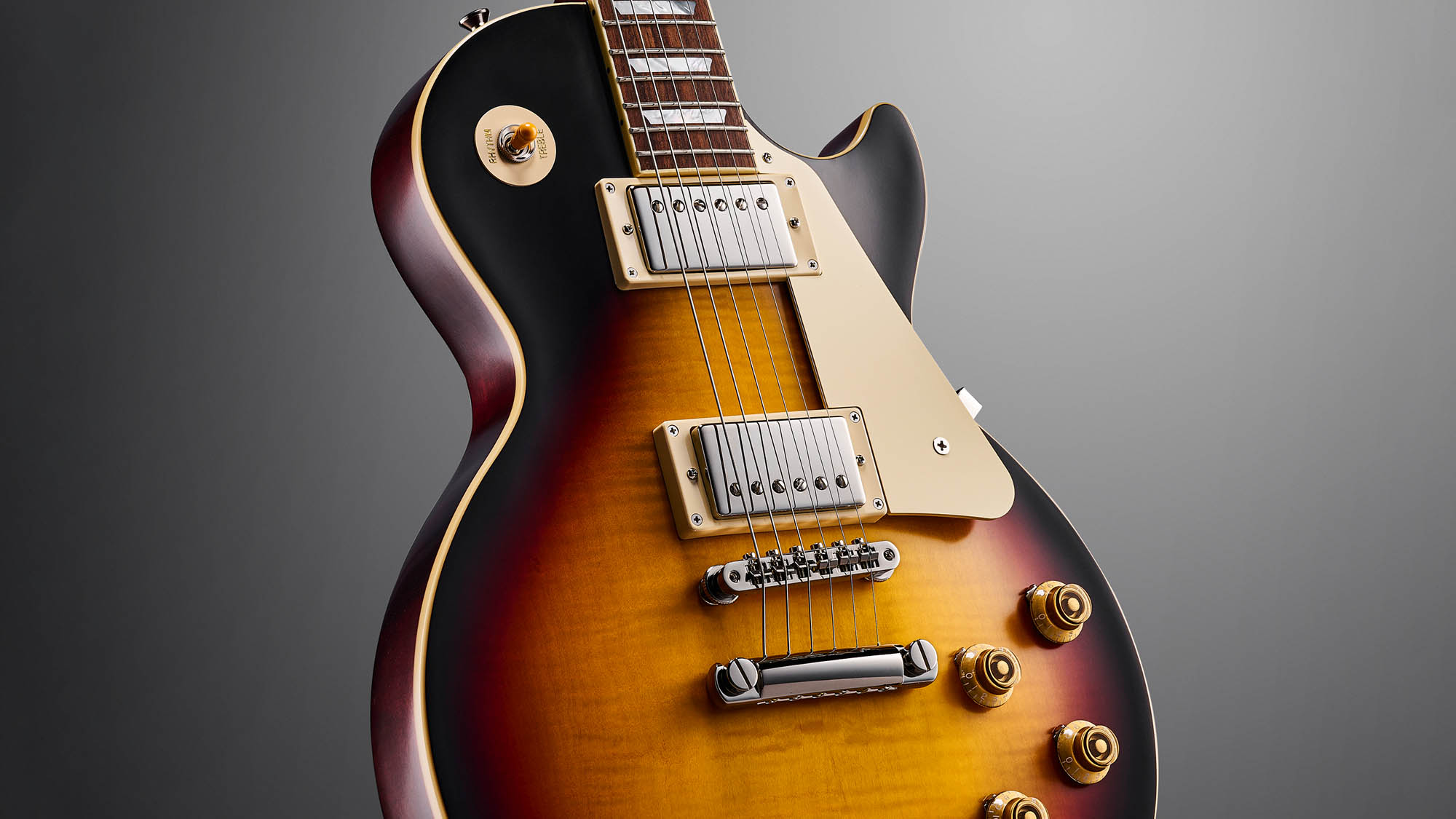
Here at Guitar World, we are experts in our field, with many years of playing and product testing between us. We live and breathe everything guitar related, and we draw on this knowledge and experience of using products in live, recording and rehearsal scenarios when selecting the products for our guides.
When choosing what we believe to be the best Epiphone Les Pauls available right now, we combine our hands-on experience, user reviews and testimonies and engage in lengthy discussions with our editorial colleagues to reach a consensus about the top products in any given category.
First and foremost, we are guitarists, and we want other players to find the right product for them. So we take into careful consideration everything from budget to feature set, ease of use and durability to come up with a list of what we can safely say are the best Epiphone Les Pauls on the market right now.
Read more about our rating system, how we choose the gear we feature, and exactly how we test each product.
Why trust us

☑️ A global audience of 3.8 million guitarists monthly
☑️ 1,200+ reviews on GuitarWorld.com
☑️ 30+ years of product testing at Guitar World
Guitar World boasts over 44 years of expertise and stands as the ultimate authority on all things related to guitars. The magazine and website feature expertly written gear round-ups and top-quality, authoritative reviews penned by a team of highly experienced industry professionals.
Guitar World's inaugural print issue hit the shelves in July 1980, and ever since, it has been captivating players and enthusiasts with engaging lessons, insightful interviews with the biggest guitar heroes, and priceless buying advice for newbie players.
Furthermore, GuitarWorld.com continues this legacy online and serves as the hub of the world's foremost authorities on guitar playing. The site not only hosts content from Guitar World but also showcases articles from respected publications such as Guitarist, Total Guitar, Guitar Techniques, and Bass Player. With a reach extending to 3.8 million players each month, GuitarWorld.com is a go-to destination for guitar fanatics globally.
Below you'll find more information on the expert author of this guide.

Jonathan Horsley has been writing about guitars since 2005, playing them since 1990, and regularly contributes to publications including Guitar World, MusicRadar and Total Guitar. He uses Jazz III nylon picks, 10s during the week, 9s at the weekend, and shamefully still struggles with rhythm figure one of Van Halen’s Panama.

Daryl is a Senior Deals Writer at Guitar World, where he creates and maintains our 200+ buyer's guides, finds the best deals on guitar products, and tests the latest gear. His reviews have been featured in prominent publications like Total Guitar, Future Music magazine, and MusicRadar.com.
During his career, he has been lucky enough to talk to many of his musical heroes, having interviewed Slash and members of Sum 41, Foo Fighters, The Offspring, Feeder, Thrice, and more. In a past life, he worked in music retail. For a little under a decade, he advised everyone from absolute beginners to seasoned pros on the right gear for their needs.
Related buyer's guides
You can trust Guitar World
- Epiphone vs Gibson: what's the difference?
- Stand out from the crowd with one of the best offset guitars
- From Fender to Gibson, Taylor to Martin, here are the best guitar brands
- On a budget? Here's the best Epiphone guitars
Get The Pick Newsletter
All the latest guitar news, interviews, lessons, reviews, deals and more, direct to your inbox!
Jonathan Horsley has been writing about guitars since 2005, playing them since 1990, and regularly contributes to publications including Guitar World, MusicRadar and Total Guitar. He uses Jazz III nylon picks, 10s during the week, 9s at the weekend, and shamefully still struggles with rhythm figure one of Van Halen’s Panama.
- Daryl RobertsonSenior Deals Writer
“It holds its own purely as a playable guitar. It’s really cool for the traveling musician – you can bring it on a flight and it fits beneath the seat”: Why Steve Stevens put his name to a foldable guitar
“Finely tuned instruments with effortless playability and one of the best vibratos there is”: PRS Standard 24 Satin and S2 Standard 24 Satin review










